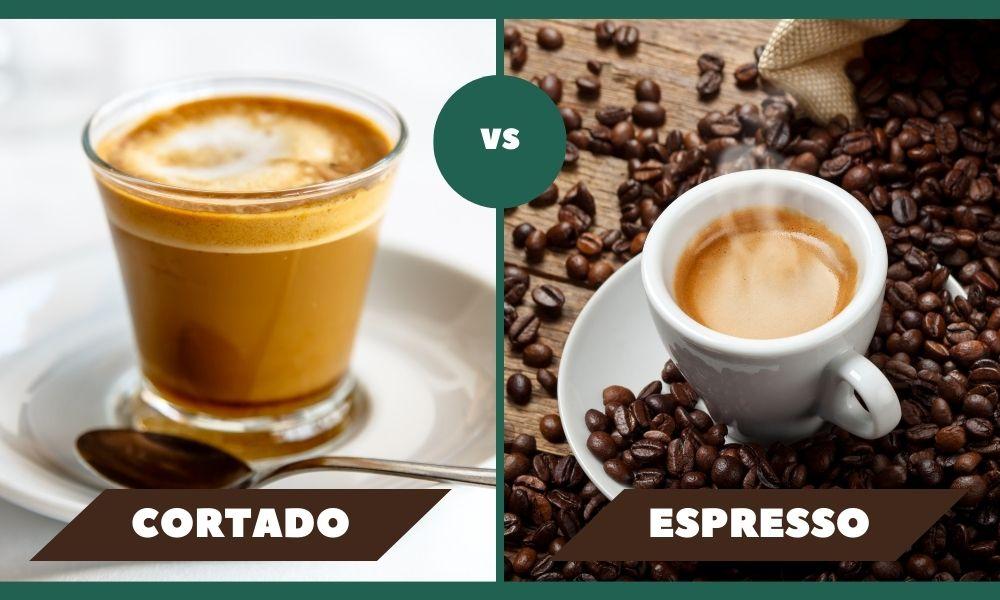From the Café latte of Italy to the Cappuccino ‘down under’, every region has its unique coffee culture. Two beloved standouts in this worldwide coffee exchange are the Cortado and the Espresso. While both share a foundation of bold, rich espresso, there lie significant differences between the two. Let’s dive deep into the distinction in taste, preparation, and everything in between, of these two beloved drinks.

What Is Espresso?
While most chase the thrill of trying new drinks, a foundational understanding of the classics provides a good baseline for coffee adventurers. Espresso, one of the most basic and well-known coffee drinks and perhaps one of the most misunderstood due to its unique brewing process, serves as a prime example.
Definition and Origins
First emerged from Italy in the 20th century, espresso is a concentrated form of coffee brewed by forcing a small amount of nearly boiling water under pressure through finely-ground coffee beans. It is valued for its full-bodied and concentrated flavors, delivering a punch in a small espresso shot size.
Brewing Process
The espresso brewing process necessitates specialized brewing equipment – typically an espresso machine – to generate the necessary pressure, providing a uniform extraction that captures the full spectrum of flavors, from the acidic top notes to the deep, bitter undertones. It’s worth noting the critical role that coffee roast types and specialty coffee beans play in achieving that distinctive espresso taste.
Characteristics of Espresso
Espresso is typically served in a small, ceramic cup and yields about 1 ounce of coffee. It has a rich, creamy layer of foam called ‘crema’ on top, which is a byproduct of the high-pressure brewing process and something coffee aficionados relish. The balance of acidity and bitterness contributes to the distinct profile of espresso.
Variations of Espresso
Coffee enthusiasts may be familiar with different forms of espresso, such as ristretto, a more concentrated espresso shot, or even the cold espresso, perfect for a refreshing drink on a warm day. Yet, the world of espresso has many more tastes to offer, a significant one being the Italian coffee drinks that use espresso as the primary ingredient.
What Is a Cortado?

As you’ve discovered the world of espresso, let’s journey across the Atlantic to Spain, the birthplace of Cortado, a coffee drink often mistaken for its Italian cousin, the latte.
Definition and Origins
The term ‘Cortado’ translates to ‘cut’ in Spanish, referencing how the milk ‘cuts through’ the coffee. This cutting-edge brew is an espresso-based drink, where equal parts of steamed milk and espresso creates a unique balance, taming the acidity and toning down the strength of the espresso.
Preparation and Ingredients
The preparation of Cortado involves topping an espresso shot with an equal amount of steamed, not frothy milk. The ideal milk for a classic Spanish cortado is full-fat, which adds depth and creaminess to the drink. And bonus points for those using Home cortado equipment to craft their version of this delightful beverage.
Characteristics of Cortado
A cortado isn’t just limited to its taste but extends to its presentation. Traditionally, the cortado cup size is slightly smaller than a latte glass, allowing for an equal coffee-to-milk ratio. The cortado’s defining character lies in its texture, a smooth blend of milk and coffee with no discernible froth, which distinguishes it from other popular coffee blends.
Different Names for Cortado in Various Countries
A fun fact that you may find interesting while searching for the “best cortado coffee near me” is that it goes by different names across the globe. In Cuba, it’s called a “cortadito”, while some U.S. west coast coffee houses refer to it as a “Gibraltar” – named after the Gibraltar glass it is served in.
That’s the halfway mark in our tasty comparison of Cortado vs. Espresso. As a coffee lover myself, I fondly remember brewing hundreds of these delightful concoctions during my stint at the Boat Basin Cafe Downtown New York, casting a spell of coffee aroma that would captivate the entire café. Stay tuned for the second half, where we’ll delve into the differences and similarities of these popular beverages and learn more about distinguishing a Cortado from a latte.
Key Differences Between Espresso and Cortado
| Espresso | Cortado | |
|---|---|---|
| Origin | Italy | Spain |
| Main Ingredient | Finely-ground coffee beans | Equal parts of espresso and steamed milk |
| Taste | Punchy, full-bodied and concentrated | Smooth, balanced, less intense than espresso, strong coffee-forward flavor |
| Texture | Bold, creamy ‘crema’ layer on top due to high-pressure brewing | Silky and smooth due to inclusion of milk, no discernible froth |
| Milk Content | None | Equal amount of steamed milk |
| Serving Vessel | Small ceramic cup | Glass (smaller than a latte cup) |
| Brewing Equipment | Espresso machine | Espresso machine, steaming equipment |
| Unique Traits | Variety of forms like ristretto (concentrated shot) and cold espresso | Different names across the globe like ‘cortadito’ in Cuba and ‘Gibraltar’ in U.S. |
Taste and Acidity
The ratio of milk to coffee mainly attributes to the difference in taste between espresso and cortado. Espresso packs a powerful punch of intense flavor, while a cortado is about balance. With an equal ratio of milk and espresso, a cortado tempers the boldness of the espresso shot, producing a drink that’s smoother, less intense, but retains a strong, coffee-forward flavor.
Milk Content and Texture
Another big difference lays in the milk content in both drinks. Espresso doesn’t have any milk. In contrast, the cortado involves an equal amount of steamed milk, creating a perfect harmony between the coffee and milk. The texture of cortado is silky and smooth due to the lack of froth, contrasting from the crema top and bold texture of an espresso.
Serving Vessels
Here’s a fun difference! When ordering a cortado, it generally comes served in a glass to showcase its beautiful layers. Espresso shots on the other hand, puddle in small ceramic cups preserving heat and optimizing flavor extraction.
Similarities Between Espresso and Cortado
Common Grounds
Both beverages have espresso as their heart and soul. Despite the variations in texture and flavor, their essence lies rooted in that robust shot of this Italian classic.
European Origins
Italy gave birth to espresso, while Spain left its mark with the cortado. Both countries have a rich coffee culture, bringing us these unique coffee experiences.
How to Differentiate a Cortado from a Latte
| Factor | Cortado | Latte |
|---|---|---|
| Main Ingredient | Equal parts of espresso and milk | Espresso shot with more steamed milk |
| Taste | Balanced, coffee-forward flavor | Milder taste, more milky flavor |
| Texture/Appearance | Silky smooth, no foam | Creamy with substantial amount of foam |
| Milk Content | Equal amount with espresso | More milk than espresso |
| Serving Vessel | Typically served in a glass | Usually served in a large cup |
With all this knowledge, you may wonder about the difference between a cortado and a latte. Lattes have more steamed milk with a generous amount of foam, served in a larger cup. Cortado, on the other hand, is a lesser-known yet more balanced alternative, focusing on the equilibrium between the espresso and the steamed milk without any foam.
Conclusion
What’s the verdict then – cortado or espresso? While both drinks share the same humble espresso roots, they differ in taste, preparation, milk-to-coffee ratio, and presentation.
From the robust, intense taste of espresso to the smooth, balanced flavor of cortado, the world of coffee never ceases to amaze with its diverse offerings. So, the next time you feel adventurous, do splurge on that “decaf cortado for evening enjoyment” or a robust shot of “cold espresso recipes” to get your caffeine fix. Remember, whether it’s a cortado, an espresso, or any other coffee beverage, it’s all about discovering and enjoying your personal preferences.
References and Sources: